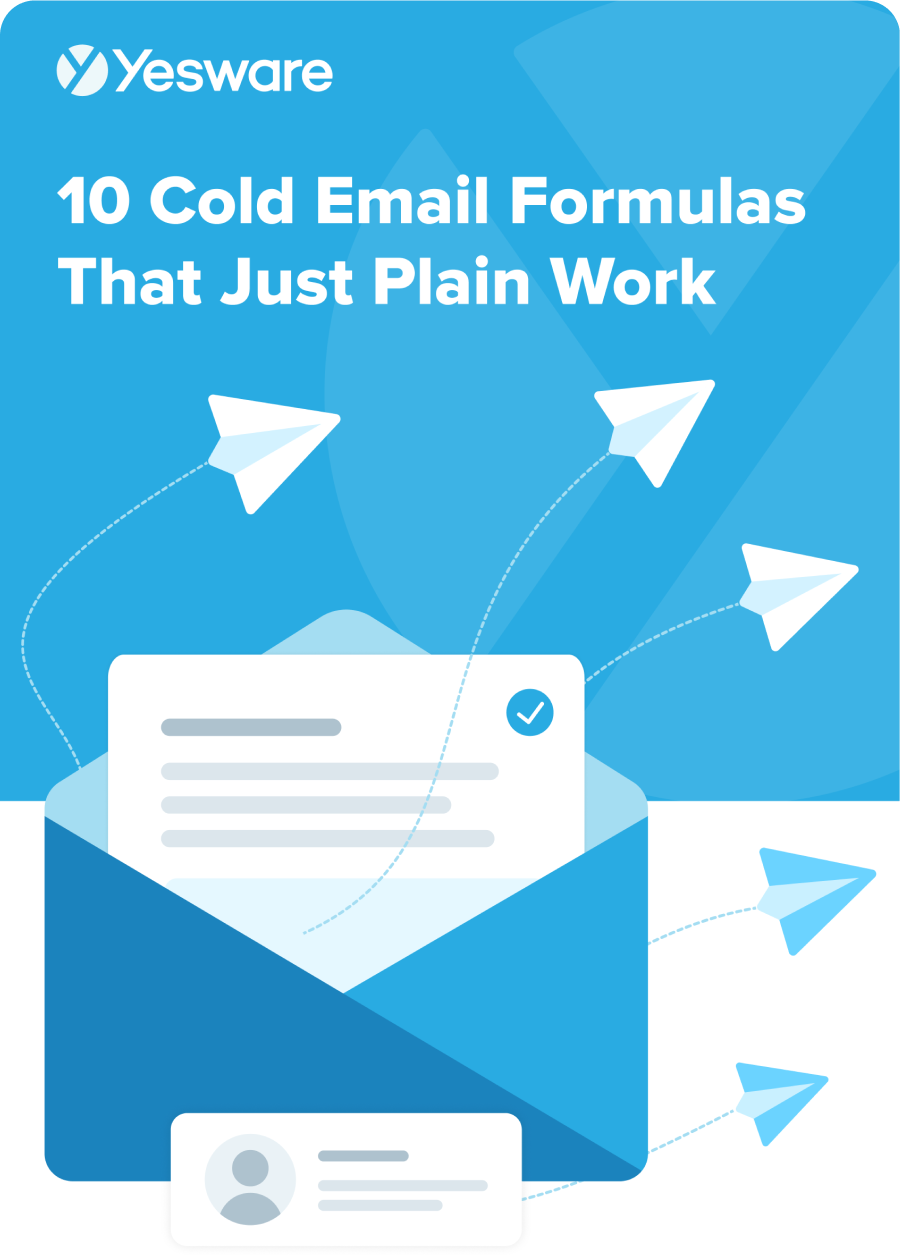4 Winning Approaches for Writing a Cold Email
Matthew Bellows
Breaking through with a cold email for a hot prospect is tough… you’ve deleted enough of them to know.
It would be much better to get an introduction from someone who knows your prospect already. But if that’s not possible, your cold sales email has two jobs:
- Get through the prospect’s personal spam filters
- Make enough of an impression to get to “The Crux” and “The Ask”
Subject Line
Getting through the personal spam filters is all about being specific in your cold email subject line, immediately adding value, and not being too sales-y. For this purpose, I suggest a tight and directed subject line. These usually work for me:
Congratulations subject lines
“Congrats on the product release/great quarter/NYT coverage/financing/new customer” (the more specific the better). If you are writing to the head of product development, product or feature messages are best. Want to meet with the VP of Sales? They all like congratulations on a great quarter.
Praise subject lines
“I’ve heard about your skills and wanted to get in touch” or “I’ve been following your efforts/blog/tweets/sales success for quite a while and wanted to reach out”. The key here is to be genuine, impressed, but not fawning. If you have no backbone, no one wants to hear your praise. On the other hand, if you are haughty, why are you writing?
The key here is to be genuine, impressed, but not fawning. If you have no backbone, no one wants to hear your praise.
Adding value subject lines
“Hi Ted! I found an article on [your industry/competition/field] and thought of you” I start out with using the prospect’s name so they know it’s not spam, and then immediately let them know that the message is relevant to their work life. Using the person’s name like that can work well in the other types of sale emails as well.
Off topic but relevant subject lines
These are dangerous. You don’t want to sound like you are stalking. These also take a bit longer until you can get to business. However, if the person you want to talk with just posted a question about their upcoming ski vacation, and you are genuinely inspired, spend some time putting together your best recommendations (with links) and email it to them. Subject lines for that approach: “Recommendations for your ski trip: I’d say Utah” or “Saw your post about skiing – here are my suggestions.” If it’s relevant, timely and not too personal, this could work well.
 10 Cold Email Formulas That Just Plain WorkSee how B2B sales professionals are using these cold email templates to engage more prospects, fill the top of their funnel and build more sales pipeline faster.
10 Cold Email Formulas That Just Plain WorkSee how B2B sales professionals are using these cold email templates to engage more prospects, fill the top of their funnel and build more sales pipeline faster.
Make an Impression
Once you have an approach and a tight subject line, you’ve got to make an impression. Making enough of an impression is mostly about the value you can provide to the recipient in the first one-to-three lines of the email. For each of the approaches above, here’s a sample email opening:
Congratulations
“Dear Ted, You and your team have really accomplished something. The feature/product/press mention yesterday is making a big impression among the people I talk to. I wanted to reach out and say congratulations.” Don’t start these with the word “I”. This is a note about your prospect.
Praise
“Dear Ted, We haven’t met in person but I’ve been impressed with your work/blog/leadership in [specific example] for some time. This isn’t a particularly easy environment to excel in. Amazing work.”
Adding value
“The article appears in The Economist this week. I thought it did a good job of capturing the dynamics of [the situation]. Here’s the link:…” By citing the source at the top, it helps establish credibility for you and the email. Don’t bother with this approach if your source isn’t bulletproof. Bonus points: “Although the author misses [some specific aspect that only an industry vet like you would know] I thought this article was pretty insightful.”
Bonus points: “Although the author misses [some specific aspect that only an industry vet like you would know] I thought this article was pretty insightful.”
Off-topic
With this approach, you need to spend some time thinking through this. Where have you been? You want to be sensitive about the places that you think the prospect would like. Do they have kids? No one wants to spend a lot of money, so put all your suggestions in terms of “value” even if they are five star. Again, getting too personal is dangerous. It’s better not to, unless you can be subtle or it’s common knowledge. Here’s an opening that I’d use: “Dear Ted, I’ve been skiing since I was six, and I lived in Colorado for four years, but for a vacation like you posted about, I’d suggest Utah. Here are my three favorite resorts and hotels.” Notice that I’m using “I” here. Since these recommendations are coming from you personally, it’s better to take this approach than the grammatical gymnastics required to avoid it.
“The Crux”
And now, “The Crux”. You have to leverage the good will you’ve created to get something in return. Here are a couple of approaches I like. They aren’t strictly related to the openings, so feel free to mix and match.
Always say “my company” even if I don’t own the company, because it communicates my responsibility for the situation.
Congratulations
“My company has been doing pretty well also. We recently announced [customer/competitor] as a client for our [product]. Maybe something like this could help you continue your impressive momentum?” I always say “my company” even if I don’t own the company, because it communicates my responsibility for the situation. I’m going to act like the owner. At the very least, I’m in charge of this relationship. That one little word “My” goes a very long way.
I always say “my company” even if I don’t own the company, because it communicates my responsibility for the situation.
Praise
“I was wondering if I could ask you a couple of questions. My company is having some success with [product/service] but your insights on/experience with could really help us accelerate.”
Adding value
“I’ve been thinking about this because my company is struggling with the same issue. Although we just launched
Off-topic
Get right to the point: “I hope you find this helpful, and you have a great vacation.” I wouldn’t follow this approach up with “The Asks” below. Close out the email while the prospect has a small amount of goodwill towards you. Then write back not sooner than ten business days with a “Hi Ted, I wrote you that note about Utah skiing a while ago. I thought of you again when talking with my product manager about [new feature/new product]…”
“The Ask”
Next, “The Ask”. If you haven’t sucked up too much, or been too stalker-y, there’s no problem here. Just be specific. I say something like:
- “I’d like to follow up about this with a quick phone call. We can cover the important issues in 20 minutes. Can I call you next Tuesday at 8am EST?”
I always ask for a phone call. You don’t need (or want) permission to send more product information. You want to take the next step in building a relationship, which is a spoken conversation. I always give a specific time and day.
It takes away the excuse of “now I have to suggest a time, etc. for this guy” Most people who are at all interested will check their calendar for that day. I try to suggest a time three to five days in advance, and at the beginning of the day – a time when they are in the car or out of a meeting. I strongly discourage any suggestion that you and your prospect spend time together beyond that call. You might both like skiing or baseball, but don’t go there until you are sure you won’t get turned down.
In real life, you’d clear your calendar for an hour with person, but you can’t ever appear that desperate. The value of each of your prospects determines how much time you can spend on writing these emails, but for most B2B salespeople, it’s hard to spend too much time getting these openings right. No spelling mistakes. No grammatical errors. I read my messages out loud before I send them. I often ask a colleague to read them before I send.
Follow-up
And then – follow up… The best salesman in the USA says ‘I get 85% of my new business after four contacts.’
And then – follow up. Not soon. Remember, you are busy. But think of the person, and try to send them something that would help them in the next 12 to 15 days. The best egg salesman in the USA says “I get 85% of my new business after four contacts.”
Jack Daly says that on average “it takes nine touches to get someone’s attention.” So keep at it over the next couple of months. I’ll cover suggestions for those emails coming up next.
Get sales tips and strategies delivered straight to your inbox.
Yesware will help you generate more sales right from your inbox. Try our Outlook add-on or Gmail Chrome extension for free, forever!
Related Articles
Melissa Williams
Melissa Williams
Casey O'Connor
Sales, deal management, and communication tips for your inbox

